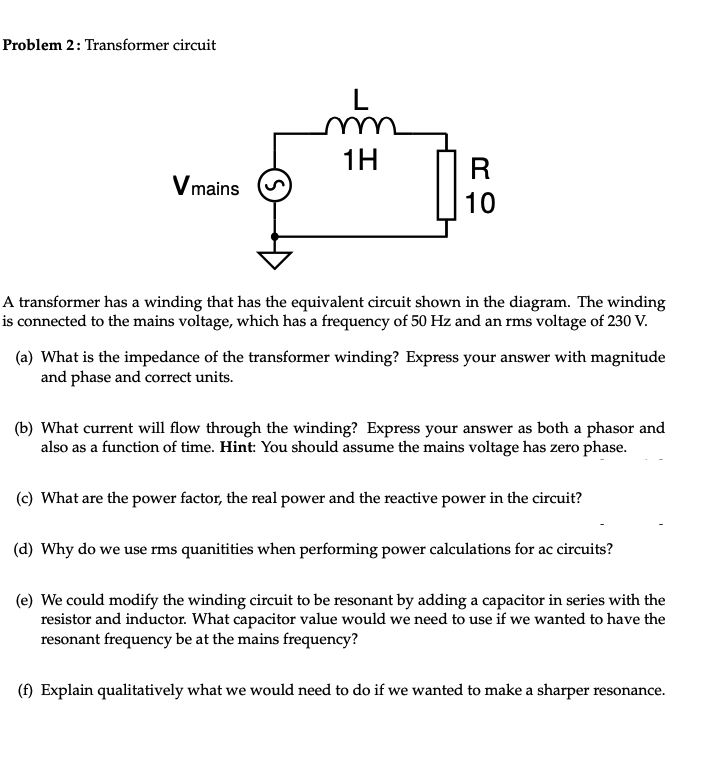Problem 2: Transformer circuit 1H R V mains 10 A transformer has a winding that has the equivalent circuit shown in the diagram. The winding is connected to the mains voltage, which has a frequency of 50 Hz and an rms voltage of 230 V. (a) What is the impedance of the transformer winding? Express your answer with magnitude and phase and correct units. (b) What current will flow through the winding? Express your answer as both a phasor and also as a function of time. Hint: You should assume the mains voltage has zero phase. (c) What are the power factor, the real power and the reactive power in the circuit?
Problem 2: Transformer circuit 1H R V mains 10 A transformer has a winding that has the equivalent circuit shown in the diagram. The winding is connected to the mains voltage, which has a frequency of 50 Hz and an rms voltage of 230 V. (a) What is the impedance of the transformer winding? Express your answer with magnitude and phase and correct units. (b) What current will flow through the winding? Express your answer as both a phasor and also as a function of time. Hint: You should assume the mains voltage has zero phase. (c) What are the power factor, the real power and the reactive power in the circuit?
Power System Analysis and Design (MindTap Course List)
6th Edition
ISBN:9781305632134
Author:J. Duncan Glover, Thomas Overbye, Mulukutla S. Sarma
Publisher:J. Duncan Glover, Thomas Overbye, Mulukutla S. Sarma
Chapter3: Power Transformers
Section: Chapter Questions
Problem 3.58P: A single-phase two-winding transformer rated 90MVA,80/120kV is to be connected as an autotransformer...
Related questions
Question
question below

Transcribed Image Text:Problem 2: Transformer circuit
L
m
1H
R
Vmains
10
A transformer has a winding that has the equivalent circuit shown in the diagram. The winding
is connected to the mains voltage, which has a frequency of 50 Hz and an rms voltage of 230 V.
(a) What is the impedance of the transformer winding? Express your answer with magnitude
and phase and correct units.
(b) What current will flow through the winding? Express your answer as both a phasor and
also as a function of time. Hint: You should assume the mains voltage has zero phase.
(c) What are the power factor, the real power and the reactive power in the circuit?
(d) Why do we use rms quanitities when performing power calculations for ac circuits?
(e) We could modify the winding circuit to be resonant by adding a capacitor in series with the
resistor and inductor. What capacitor value would we need to use if we wanted to have the
resonant frequency be at the mains frequency?
(f) Explain qualitatively what we would need to do if we wanted to make a sharper resonance.
Expert Solution
This question has been solved!
Explore an expertly crafted, step-by-step solution for a thorough understanding of key concepts.
Step by step
Solved in 4 steps with 2 images

Knowledge Booster
Learn more about
Need a deep-dive on the concept behind this application? Look no further. Learn more about this topic, electrical-engineering and related others by exploring similar questions and additional content below.Recommended textbooks for you

Power System Analysis and Design (MindTap Course …
Electrical Engineering
ISBN:
9781305632134
Author:
J. Duncan Glover, Thomas Overbye, Mulukutla S. Sarma
Publisher:
Cengage Learning

Power System Analysis and Design (MindTap Course …
Electrical Engineering
ISBN:
9781305632134
Author:
J. Duncan Glover, Thomas Overbye, Mulukutla S. Sarma
Publisher:
Cengage Learning